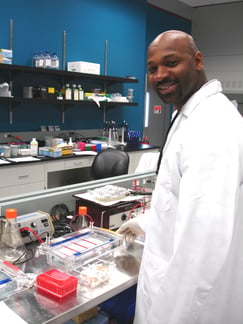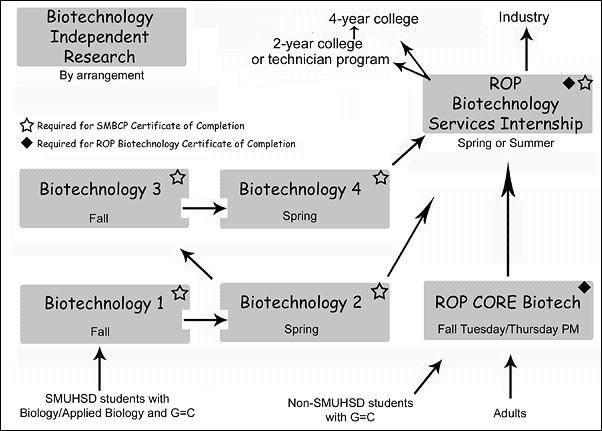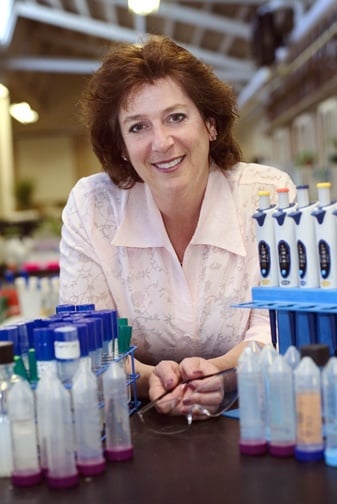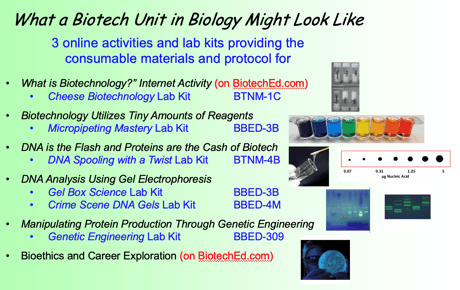By Ellyn Daugherty, Biotechnology: Science for the New Millennium, 2E
Biotechnology courses are popping up all over the country, with several hundred community colleges and high schools delivering programs that prepare students for a rewarding career in biotech. This is not surprising since biotechnology is the largest STEM employer in the world and it is such a high-interest area for both students, teachers and the workforce community.
-
Biotechnology courses arm students with the experiences and knowledge needed to make good decisions about their academic and career futures.
-
Educators find that teaching the processes of biotechnology supported by the high-level concepts of science empowers them and improves their own science skills.
-
Adults in the workforce find excellent pay and benefits in jobs that make a difference and improve the quality of human life.
Biotechnology courses allow science educators to teach in a way that students develop a love for the process as well as the concepts of the biochemical sciences. Students learn research skills and get an idea of what it feels like to work in a laboratory environment. Biotechnology courses help develop the scientists, research associates, lab technicians, and science-literate citizens needed in our rapidly changing science-based society.
Senior Manufacturing Technician, Kevin Johnson
In his position at Affymetrix, Inc., Kevin operated and maintained high-throughput reagent filling systems.
The reagents were included with the Affymetrix microarray reader instruments.

Microarrays are used to study gene expression and genetic diversity. Gene targets for pharmaceutical research are often found using microarrays. Kevin not only uses, calibrates, and validates an assortment of common lab equipment but he also trains new lab employees. Photo by Ellyn Daugherty.
Unless educators give their students experiences in the process of biotechnology, how are students supposed to know they are interested in biotech careers and how can they be expected to make academic decisions that lead them to those careers?
When asked what biotechnology is, a typical response from an American teenager is, “CSI.” Although, forensics is a field that utilizes the tools of biotechnology, it is like cottage cheese in the dairy section of biotech, just one important application of biotechnologies. Without an exposure to many of the introductory techniques and applications of laboratory biotech and biotech’s pharmaceutical, agricultural, environmental, industrial, and diagnostic products, students cannot be expected to make decisions that lead them to academic and career choices in biotechnology.
It is important to provide all students biotech education and to consider student recruitment strategies when planning a biotechnology program. Biology (or other general science courses for 9th or 10th graders) is a perfect spot in a school’s science curriculum to place a biotech unit or activities for all students to have minimal exposure to the importance of and the opportunities in the field of biotechnology.
An Example of a Biotech Unit for Biology or other General Science Course
The San Mateo Biotechnology Career Pathway (SMBCP) program consists of courses that prepare teenagers to enter the biotechnology workplace as laboratory or bio-processing technicians, with courses taught in the San Mateo Biotechnology Training Center and in laboratory internships at one of 25 industry and academic partners. Depending on the student and the experience they prefer, students may stay in the program from one to four years. The SMBCP program runs five 1st year courses of Biotechnology 1-2 for teenagers each year and recruits 175 new sophomores and juniors into these courses. These students represent all academic and socioeconomic levels.
To successfully meet these enrollment goals, the San Mateo Union High School District (SMUHSD) science teachers implement several methods to educate potential students about the science and industry of biotechnology and stimulate their interest in the opportunities in the field.
The San Mateo Biotechnology Career Pathway

An introduction to biotechnology for SMUHSD students begins in the freshman biological science course. All students in the district have a science course during 9th grade. Usually this course is Biology 1-2, although it might be Integrated Science 1-2 or a physical science.
Each of these courses includes a biotechnology unit or set of activities called “The Gene Connection®.”
How “The Gene Connection®” (G-C) unit is implemented at a site depends on the school. Science teachers at a school site may choose to run their own version of “G-C” type activities or may participate in G-C training and then have access to the equipment, materials, or curriculum available from the San Mateo County Gene Connection® program or the regional BABEC organization. G-C acitivities may be sprinkled in throughout the course or may be presented as a stand-alone unit.
At San Mateo High School, students in all of the Biology classes (the prerequisite course for Biotech 1-2), complete approximately 4-5 weeks of a biotech primer unit that consists of 6 lab activities and a handful of computer and bioethics activities. The activities are provided as kitted experiments from the County Office of Education. For the rest of the country’s educators these lab activities are available as kits from vendors such as G-Biosciences, Inc. (Biotechnology Basics™ by Ellyn Daugherty) or others. Additionally, ideas for lab activities and biotechnology lessons are shared online as shared by fellow educators.
Suggested Biotechnology Unit/Activities (Biotech Primer) for Biology Course
|
Biotech Primer Activity |
Objective |
Lab Kit Vendor/ Source |
Comments, Notes |
|
Biotechnology Product:Cheese Making Made Better |
Students produce cheese using different curdling agents including a recombinant enzyme |
Focus on scientific methodology and an overview of genetic engineering technology |
|
|
DNA Isolation and Spooling |
Students pull pure DNA strands out of a solution and quantify the yield. |
Afterwards, try www.exploratorium.com or find the web article, “Extract DNA from Anything.” |
|
|
Introduction to Micropipeting |
Students learn how to measure very small volumes using a variety of micropipets. |
It is pretty easy to train students and have them demonstrate their micropipetting skills. |
|
|
Introduction to the Biology, Chemistry and Physics of Gel Electrophoresis |
Students study charge, current, voltage during electrophoresis and molecular behavior in a gel placed in an electric field. |
Students run a variety of DNA samples through a gel along with other positively and negatively charged molecules. |
|
|
DNA fingerprinting |
Students conduct a DNA fingerprint simulation using restriction enzyme digestion (RFLPs). |
DNA studies/forensics careers prior to DNA fingerprinting and bioethical dilemmas afterwards. |
|
|
pGLO transformation of E. coli |
Students conduct a genetic engineering procedure to create a GMO. |
|
Nova® or Frontline® GMOs videos prior to lab and bioethical dilemmas after. |
-
BBED Lab Kits and protocols available from G-Biosciences at
Biotechnology in Biology for Everybody
Biotechnology is growing faster than any other industry and a rapidly increasing number of employees are needed in all sectors of the science and business of biotech. The shortage of appropriately prepared candidates for positions in biotech research and development as well as manufacturing is becoming a serious concern for many bioscience companies. It is such a concern that companies are building strategic alliances with their local educational institutions, including both colleges and high schools, to increase the number of qualified employees. To create the science workforce of the 21st century, we need students of all ages to develop an interest in pursuing a career in biotechnology. Providing biology students with positive lab experiences in biotechnology will increase the number of students entering specialized biotechnology programs and careers in biotech.







